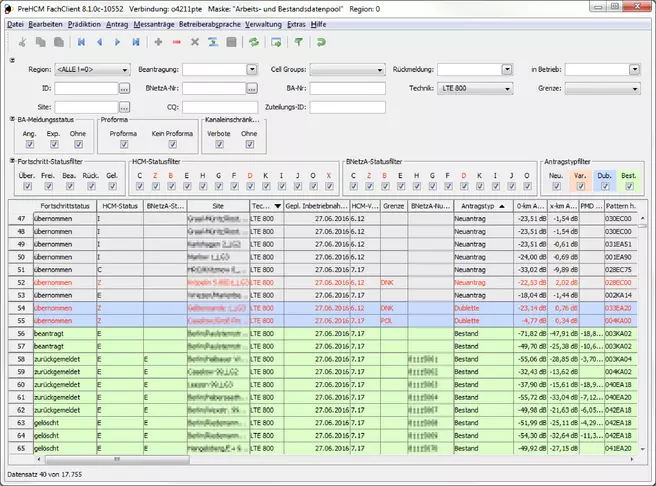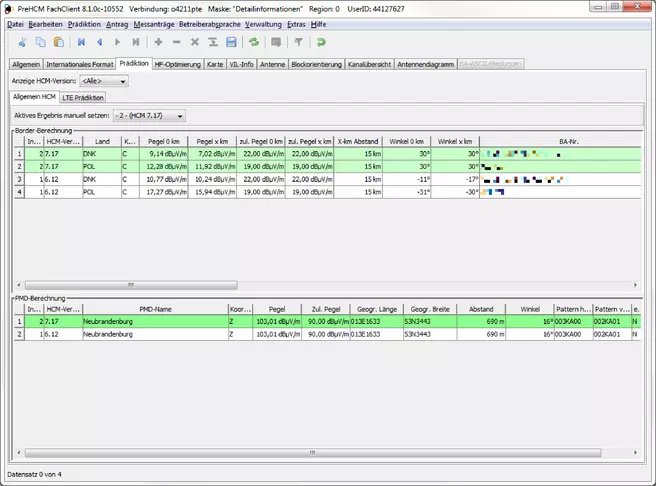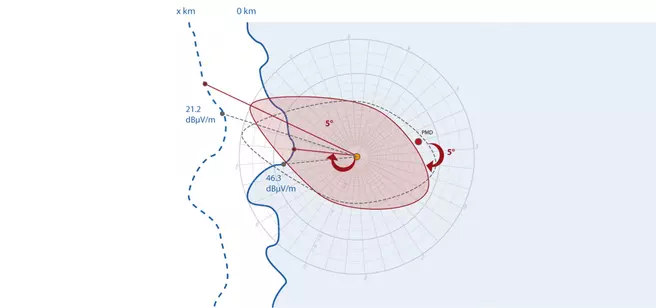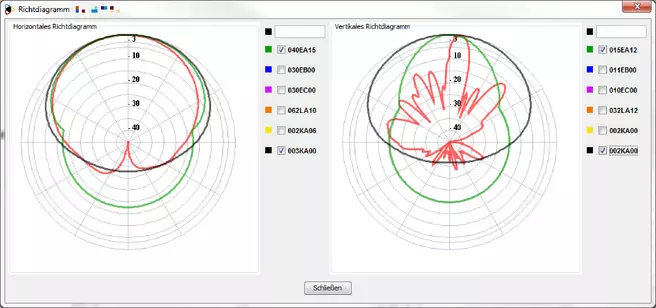PreHCM Mobile is a modular System to automate the Frequency Assignment and Authorization Processes for German Mobile Network Operators
Representatives from seventeen national telecommunication authorities signed the HCM agreement coordinating the frequency range between 29.7 MHz and 43.5 GHz. The HCM agreement aims to prevent harmful interference and optimizes the use of resources in border areas.
In cross-border situations, radio network planning in Germany is significantly restricted by the Federal Network Agency for Electricity, Gas, Telecommunications, Post and Railway (BNetzA). Radio cells with too high field strength at the border or radio monitoring sites do not receive an operating license. In these rejected coordination situations, especially economic planned sites cannot be used.
PreHCM Mobile is optimized for German mobile network and trunked radio operators. It complies with current German regulatory requirements (telecommunication act § 55 TKG) and is aligned to the focus of border coordination according to the HCM agreement. The modular system solution automates the entire frequency coordination process (GSM, UMTS, LTE, GSM-R, TETRA, PMR, trunked radio, analogue radio and more) and integrates the primary frequency authorization process with the BNetzA in the operational network planning.
Included procedures are:
- Parameter setting process for the BNetzA
- PMD coordination
- GSM-R coordination
- Mobil frequency coordination vs. broadcasting
- Cross-border coordination
- Consideration of operator agreements
PreHCM International offers Cross-Border Frequency Coordination for non-German Mobile Network Operators
PreHCM International is a software solution for mobile network operators to fulfil frequency coordination compliance defined by national telecommunication authorities.
In the European Union (EU) and especially in participating countries of the HCM agreement, frequency coordination with neighbouring countries is based on the HCM algorithm (harmonized calculation method) and dependents on various radio parameters. Especially in cross-border situations, radio network planning is significantly restricted. The radio base stations may not exceed certain field strength values at radio monitoring site stations. These limits also depend on the frequency band. Radio cells with too high field strength at the border or radio monitoring sites do not receive an operating license. In these rejected coordination situations, especially economic planned sites cannot be used.
The consequences: expensive re-planning for a new site, renovations at existing sites or complete relocation. In many cases, such enormous subsequent costs can be prevented by HCM site optimization.
PreHCM International is the answer to these problems and the right solution to comply with international cross-border agreements and national regulation (like authorization processes, radio monitoring sites, broadcasting coordination and coordination of mobile radio services for railway).
The system handles all common mobile network technologies like GSM, UMTS, LTE, GSM-R, TETRA, PMR, trunked radio, analogue radio and more. It provides simulation and prediction of frequency coordination down to the level of single radio cells (based on the latest HCM version v7) and an automation of the according regulatory processes. Optimizations reach from the single cell coordination (HCM pattern / Vienna pattern) to operator agreements.
The solution is specially designed for the needs of mobile network operators with different radio systems in different frequency bands. It allows you to directly integrate frequency coordination in the operative radio network planning process. Therefore it provides massive cost optimizations through the early consideration of regulatory limitations.
PreHCM International can be integrated into existing systems or used independently. The program is designed to process large quantities of data. Calculated HCM prediction results can be delivered as clear reports or detailed views.
PreHCM Government is a Frequency Management System for public Telecommunication Authorities
PreHCM Government is designed for telecommunication authorities (spectrum management) to establish modern eGovernment processes by managing the frequency authorization of mobile network operators. The solution allows you to manage frequency assignment, coordination and authorization, especially optimized for harmonized approaches like HCM (harmonized calculation method).
PreHCM Government includes a complete HCM prediction based on the latest version HCM v7. The system is designed to process large quantities of data. It can be integrated into existing systems or used stand-alone. The system is technology and frequency spectrum independent.
The included database records all site data from mobile network operators. Advantages of the database system include:
- Easy data exchange with neighbouring administrations
- Detection and consideration of operator agreements
- Consideration of national agreements
- Coordination procedures including timetables and tracking
- Recording of test measurement results
One stop solution for your daily telecommunication regulatory management
PreHCM adds frequency coordination and frequency license request processes to your operational radio planning processes.
Tried and true product – known for years
Challenging customer demands and honest feedback helped us to provide you with a proven, robust and highly efficient off-the shelf product.
Individual use cases for your individual demands
You can make your choice whether you want PreHCM provided as software, as a service or as local web or client/server application. More software modules such as HCM area calculation, antenna patter improvement can be integrated at your request.
Optimize sites according to regulatory requirements – and save on costs
Adding regulatory requirements as additional dimension in radio network planning helps to find a cost efficient solution for your network. In doing so savings can be utilized early on.
Specialist counselling
PreHCM is not just a software company – it is a solution provider. We offer a complete set of services for your operational regulatory management processes. Our bandwidth reaches from software adaptions over counselling up to expert studies.
More than 15 years expertise in radio management
PreHCM Services acts as appointed authorized representative towards regulatory authorities, cooperates with international bodies and committees and is a well-respected partner for telecommunication regulation.
End to End Business Process handling
Our end to end business process handling covers the entire life cycle of a radio site to be coordinated
Starting with very initial application preparation tasks up to taking the site out of service.
- Identification of change needs
- Pre-check with site-check module
- Predecessor – successor relationship
- Separating archive from working data
- Checking replies timewise
- Archiving of out of service sites
- Full application documentary
HCM Radio propagation prediction
Calculation of radio coverage footprints based on HCM algorithm
- Anticipate referencing the evaluation process performed by BNetzA
- Border lines
- Measurements
- Operator agreements
- Sub Processes such as protected areas, GSM-R or Radio broadcast regulation
- Use of existing map data
- Calculating field strength levels both on border line and on x-km line
- Calculating field strength levels at radio monitoring sites
- Identification and optimizing sites which exceed field strength limits
- HCM format (international standard)
- XML format
- Individual formats and national standards
Regulation of Frequency Assignment and Coordination
National and international Agreements and Provisions
To prevent wireless telecommunication systems (in the frequency range from 29.7 MHz to 43.5 GHz) from harmful interference in frontier zones, 17 European countries signed the HCM agreement to coordinate their frequency allocation.
HCM stands for Harmonised Calculation Method which is used to predict a field strength level produced by radio sites at the borderline and on a line x-km away from borderline in foreign territory. The prediction model (latest version V7) goes back to ITU-R recommendation P.1546 and adopts it to the case of frequency coordination.
Main topics of the HCM agreements are:
- Improved frequency utilisation in frontier zones
- Prevention of harmful interference
- Reasonable site protection
- Prediction calculation model according to ITU-R recommendation P.1546 used
- Allocation principles for preference frequencies (GSM) or preference code sets (UMTS)
- Definition of field strength limits on borderline and on x-km line
- Fast interference evaluation by exchanging site data between operators
- Coordination of frequencies by using the harmonised prediction model
- Determining data formats (XML, international data standard)
Frequency coordination based on HCM agreement makes radio planning for mobile radio networks in frontier zones more restrictive. In single cases certain sites won’t make sense from an economical point of view any more.
National regulatory authorities (BNetzA in Germany) are in charge to monitor compliance with international agreements.
In Germany an administrative fiat ("Entscheidung der Präsidentenkammer der Bundesnetzagentur für Elektrizität, Gas, Telekommunikation, Post und Eisenbahnen vom 28. Januar 2015 zur Anordnung und Wahl des Verfahrens sowie über die Festlegungen und Regeln im Einzelnen (Vergaberegeln) und über die Festlegungen und Regelungen für die Durchführung des Verfahrens (Auktionsregeln) zur Vergabe von Frequenzen in den Bereichen 700 MHz, 900 MHz, 1800 MHz sowie weiterer Frequenzen im Bereich 1452 – 1492 MHz für den drahtlosen Netzzugang zum Angebot von Telekommunikationsdiensten; Entscheidung gemäß §§ 55 Abs. 4, Abs. 5 und Abs. 10, 61 Abs. 1, Abs. 2, Abs. 3, Abs. 4 und Abs. 6, 132 Abs. 1 und Abs. 3 TKG") describes the concept of operator agreements.
This allows operators to deviate from regulatory restrictions if operator agreements concluded.
Operator agreements require authorization from regulatory Authorities.
PreHCM provides consulting and support on all aspects around operator agreements independent of frequency band and technology:
- First contact with European operators
- Establishing and negotiating operator agreements
ITU together with European Commission started to work on harmonizing policy and regulations for information and communication technologies (ICT) across Sub-Saharan Africa. Building on the success of a joint project conducted in West Africa a new initiative was launched (HIPSSA Support for Harmonization of the ICT policies in Sub-Saharan Africa)
ITU and EU support participating countries to establish their own regulatory framework for frequency utilisation and harmonisation in border areas, based on the HCM agreement.
Main topics of the negotiations are:
- Improved frequency utilisation in frontier zones
- Prevention of harmful interferences
- Reasonable site protection
- Determination of technical rules and standards
- Definition of administrative proceedings
- Allocation principles for preference frequencies (GSM) or preference code sets (UMTS)
- Comprehensible regulatory decisions due to predefined checking criteria
- Fast interference assessment by defined exchange of data
- Frequency coordination by using the harmonised prediction model for Africa (HCM4A)





